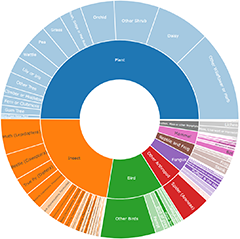Lilies & Irises
This group includes any herbaceous monocot that has prominent flowers in which the flower parts are in two whorls. Monocots have one seed leaf compared to two in dicotyledons. Mature plants are recognised by parallel longitudinal veins in their often narrow leaves and by having flowers parts in threes or multiples of three.
Identification is largely on differences in flower parts, the number of flowers borne at each part of the stem from which a leaf is attached or on the form of basal leaves. Ideally records for lilies and irises should include close-up photographs of the flowers and basal leaves and a shot that shows flower arrangement along the stem.
Announcements
There are currently no announcements.
Discussion
Heinol
wrote:
1 hr ago
Over the years I have kept a lookout for this twining Thysanotus in Black Mountain and have seen it a few times. Some days ago I found it right alongside fire trails or foot tracks at a number of points and a look around at each point usually revealed a few more plants. During this ramble of about two hours I found more plants than the total of all my Black Mountain sightings of it over the past 2 or 3 decades and almost every plant had more unopened buds than flowers.
Thysanotus patersonii
abread111
wrote:
Yesterday
No it doesn't. B. glauca is more from the Murrumbidgee valley - its common name is rock lily - it likes waterfalls!
There is plenty of B. bulbosa in the Mount Majura woodlands.
There is plenty of B. bulbosa in the Mount Majura woodlands.
Bulbine glauca
Tapirlord
wrote:
Yesterday
Ahh I see. I woudln't think it is a huge issue. B.glauca would occur elsewhere on Mt Majura I would expect?
Bulbine glauca
abread111
wrote:
Yesterday
You are right! This is not a planted site. Lots of native B. bulbosa around now
Bulbine bulbosa
Significant sightings
- Thelionema umbellatum at Tinderry, NSW
- Dianella tarda at Castlemaine, VIC
- Dianella amoena at Barrington Tops, NSW
- Iris orientalis at Cooma North Ridge Reserve
- Dianella tarda at Suttons Dam
- Ornithogalum umbellatum at Watson, ACT
- Doryanthes excelsa at Fingal Bay, NSW
- Burchardia umbellata at Hackett, ACT
- Arthropodium glareosorum at Moruya, NSW
- Arum italicum at West Albury, NSW
Top contributors
- MichaelBedingfield 345
- trevorpreston 326
- Mike 297
- Tapirlord 259
- sangio7 199
- KylieWaldon 191
- Darcy 161
- AaronClausen 142
- MatthewFrawley 134
- MichaelMulvaney 115
Top moderators
- MichaelMulvaney 1.4K
- Tapirlord 1.3K
- MichaelBedingfield 1K
- BettyDonWood 569
- natureguy 416
- plants 220
- RWPurdie 218
- Darcy 215
- Venture 165
- JasonPStewartNMsnc2016 102








































































































